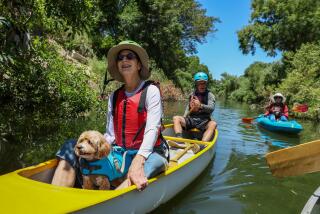Nature Takes Root in Man-Made Wetlands : Environment: A biologist says the Caltrans project near Moorpark shows demands of growth and wildlife can be met.
- Share via
Three years ago, bulldozers rolled onto 12 acres of pastureland in a basin near Moorpark and began removing 116,000 tons of dirt.
California Department of Transportation officials ordered the grading--but it was not to build a highway or widen a road. Instead, workers were beginning the lengthy process of trying to mimic nature.
Caltrans was required to create wetlands to replace six acres it destroyed when it began construction of a $36-million connector between California 23 and the Simi Valley Freeway.
Today, the area supports a thriving plant-and-water community where more than 54 bird species have been sighted, including an endangered songbird. Water-thriving trees such as willow, cottonwood and sycamore have replaced what once was scrubby flatland.
A federal biologist said the Arroyo Simi wetlands--Caltrans’ largest and most ambitious effort in Ventura County to date--shows promise as a good example of how the conflicting demands of growth and preserving nature can be met.
“Caltrans has been very successful,” said Cathy Brown, a wetlands specialist with the U.S. Fish and Wildlife Service. “I have been to the site and have been impressed with the quality of the habitat.”
For more than a decade, state and federal laws have spelled out strict guidelines that seek to protect wetlands from development. Wetlands are considered an important part of the ecosystem because so many species depend on them to survive, Brown said.
But if damage to wetlands cannot be avoided, a developer must do something to compensate, she said. Public entities such are Caltrans are not exempt from the requirements, Brown said.
“Even a small area, (such as) was impacted for the freeway connector, has a great deal of importance,” she said.
The goal is to create a habitat that is as close to nature as possible to make up for the destroyed area. After initial human intervention, the man-made habitat should become self-sustaining, officials said.
“Some (developers) create projects that are irrigated with sprinklers and they never plan to turn the sprinklers off,” said Monica Finn, a natural science specialist with Caltrans. “We’re hoping that the natural processes of nature will take over.”
There is evidence those goals are within reach at the Arroyo Simi wetlands.
The percentage of ground covered with vegetation on the western portion of the site has jumped from 5% when the project began in May, 1990, to 51% last summer, Finn said. Similar gains were made on the east side, where 5% of the ground was covered with vegetation three years ago, compared with 48% last year, she said.
Grass and cottonwood, sycamore and various types of willow trees have been planted and appear to be thriving. Also, several of the plant species, including willow and mulefat, are naturally regenerating. But the most significant indicator that the habitat is beginning to function as wetlands is the presence of numerous bird species, Brown said.
Besides common species, such as wrens, crows and finches, the wetlands attracted two male least Bell’s vireos last spring. Least Bell’s vireos are an endangered species, with biologists estimating that only about 500 nesting pairs of the songbirds remain in the United States. Scientists hope that more vireos will return to the site this year, find mates and begin nesting.
“It’s a good sign,” Brown said. “It means the vireos saw the habitat while flying over and found it attractive enough to use it.”
Contractors hired by Caltrans created the wetlands by building inlet and outlet channels connecting the basin to the nearby Arroyo Simi creek. The channels allow the area to be flushed by waters from the Arroyo Simi when there is substantial rainfall, Finn said.
Grading lowered the soil surface in order to bring plants closer to the water table, she said, with the hope that the roots eventually would reach the water. That has already occurred for much of the vegetation, she said.
Despite its early gains, one expert in biology said the long-term success or failure of the project ultimately will depend on its ability to withstand the vagaries of nature.
“The program is in its infancy,” said Muthena Naseri, who teaches environmental science at nearby Moorpark College. “It’s much too early to contemplate whether it will survive for decades to come.”
The state is scheduled to deed the man-made wetlands to the 11,000-student community college when Caltrans’ role in monitoring it ends in April, 1995. In addition to the 12 acres created by Caltrans, the outdoor classroom will include another eight acres containing existing vegetation.
Students majoring in environmental studies and zoology will come to the Arroyo Simi to look at wildlife, study plants and track stream erosion, Naseri said.
But they won’t intervene with the natural processes taking place at the wetlands, even if it appears the habitat is suffering from a prolonged drought or other act of nature, he said. He said Caltrans engineers have fought to control the growth of reed, which was sprouting so rapidly it threatened to choke off the stream.
“We’re going to leave it as is,” Naseri said. “And if it dies, that will be our conclusion about man mimicking nature. Nature will always have the last strike. Nature always wins.”
It cost Caltrans $860,000 to create the wetlands, including grading and planting the site in early 1990, Finn said. The state agency has one other mitigation project in Ventura County near Sespe Creek, but it is much smaller in size and scope than the Arroyo Simi wetlands, she said.
Other smaller projects are planned at Piru Creek near California 126 and on the Santa Clara River near Saticoy, she said. Statewide, Caltrans has been creating and monitoring wildlife habitats and wetlands to make up for acreage lost by roadwork for more than 15 years, Finn said.
Fish and Wildlife’s Brown said she is not always in favor of allowing wetlands to be destroyed and replaced by an artificial habitat elsewhere. For instance, she would not support that solution to build a golf course or a residential tract, she said.
But such compromises become necessary when the public’s need for a project--as in the case of the freeway connector--makes it the only option available, Brown said.
“In this case, the road apparently could not have been built anywhere else.”
And when the man-made habitat is done correctly, it can be a win-win situation for everyone, she said. Caltrans’ Finn agrees:
“If (the wetlands) is designed the way we hope it should be designed, it will still be there decades from now.”
More to Read
Sign up for Essential California
The most important California stories and recommendations in your inbox every morning.
You may occasionally receive promotional content from the Los Angeles Times.










